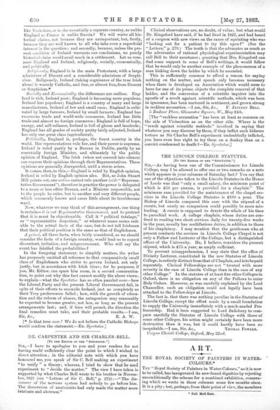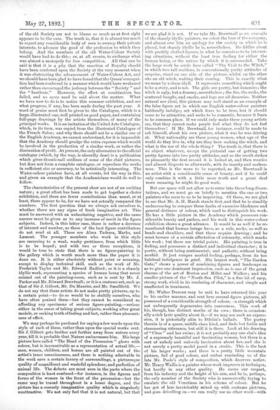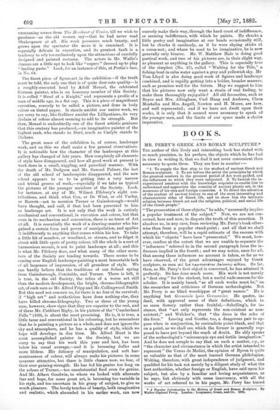ART.
THE ROYAL SOCIETY OFPAINTERS IN WATER- COLOURS.*
THE " Royal Society of Painters in Water-Colours," as it is now to be called, has inaugurated its new-found dignities by rejecting unconditionally the scheme for a combined exhibition, concern- ing which we wrote in these columns some few months since. It is a pity ; but, perhaps, from their point of view, the members
• Pall Mall East.
of the old Society are not to blame so much as at first sight appears to be the case. The truth is, that it is almost too much to expect any considerable body of men to swamp their private interests, to advance the good of the profession to which they belong. And the members of the old Water-Colour Society would have had to do this ; or, at all events, to exchange what was almost a monopoly for free competition. All that can be said is that it is a pity that the sanction of Royalty should have been conferred upon the Society at the very moment when it was obstructing the advancement of Water-Colour Art, and we should have been glad to have found that the Queen'srecogni- Eon had been conferred in a manner which would have weakened rather than encouraged the jealousy between the " Society " and the " Institute." However, the effort at combination has failed, and no more need be said about the matter. What we have now to do is to notice this summer exhibition, and see what progress, if any, has been made during the past year. A word of praise must first be given to the Catalogue, which is a large, illustrated one, well printed on good paper, and containing full-page drawings by the artists themselves, of many of the principal works. It is an imitation of theThaited A rts Catalogue, which, in its turn, was copied from the illustrated Catalogue of the French Salon; and why there should not be a similar one of the English Academy, we cannot understand, for it is impossible that the Academy should grudge the extra expense which would be involved in the production of a similar work, or rather the diminution of profit. At present, the only alternative to the official -catalogue (which, by the way, is absurdly dear) is a publication which gives thumb-nail outlines of some of the chief pictures, but does not form a complete catalogue, or reproduce the works in sufficient size or accuracy, to be artistically interesting. The Water-colour painters have, at all events, led the way in this, and given an example that the Academicians would do well to follow.
The characteristics of the present show are not of an exciting nature ; a great effort has been made to get together a choice -exhibition, and there are fewer contributions than usual, or at least, there appear to be, for we have not actually compared the numbers. The first question that we always ask ourselves is, whether there are any signs of fresh imaginative art. This must be answered with an unhesitating negative, and the same -answer must be given as to any increase of merit in the figure subjects. Indeed, in this latter case, there is rather a decrease .of interest and number, as three of the best figure contributors -do not send at all. These are Alma Tadema, Marks, and Lamont. The younger members who work in this style are recurring to a weak, washy prettiness, from which little is to be hoped ; and with two or three exceptions, it would be true to state that there is no figure-painting in -the gallery which is worth much more than the paper it is done on., It is either absolutely without point or meaning, -except to display technical skill, such as the work of Mr. Frederick Tayler and Mr. Edward Radford ; or it is a shamly idyllic work, representing a species of human being that never -existed out of the painting-room, such as is sent by Mr. J. Parker and Mr. Edward Brewtnall ; or it is a costume art, such as that of Sir J. Gilbert, Mr. Du Meunier, and Mr. Smallfield. We -do not say that these artists do not make pretty pictures, up to a certain point—to do so would be to stultify ourselves, who have often praised them—but they cannot be considered as affording any specimens of serious figure-painting,—serious slither in the sense of taking great subjects, working after great models, or seeking truth of feeling and fact, rather than pleasant- ness of effect.
We may perhaps be pardoned for saying a few words upon the style of each of these, rather than upon the special works sent. Sir J. Gilbert gets further and further away from nature every Tear, till it is probable that Nature embarrasses him. His large picture here called "The Head of the Procession " glows with colour, but is inconceivable as a representation of actual life,— men, women, children, and horses are all painted out of the artist's inner consciousness, and there is nothing admirable in the work save a certain luxury of surroundings, a picturesque quality of magnificent and wasteful splendour, and perfection of animal life. The defects are -most seen in the parts where the composition is least confused—for instance, in the figures and -forms of the women in the front of the procession—but the same may be traced throughout in a lesser degree, and the picture has a coarsely imaginative quality which is singularly unattractive. We not only feel that it is not natural, but that
we are glad it is not. If we take Mr. Brewtnall as an example of the shamly idyllic painters, we select the best of the company, and almost owe him an apology for the society in which he is placed, but shamly idyllic he is, nevertheless. He fiddles about with prettily clothed figures, in what he conceives to be interest- ing situations, without the least true feeling for either the human being, or the nature by which it is surrounded. Take the large work he sends here called "The Visit to the Witch," in which two tall maidens, in conventionally pretty attitudes of surprise, stand on one side of the picture. whilst on the other sits an old witch, waiting their coming. This is exactly what we mean by a sham idyll. It represents something which ought to be a story, and is not. The girls are pretty, but dummies ; the witch is ugly, but a dummy, nevertheless ; the fire, the rocks, the scattered boughs, and smoke, and logs are all dummies. Neither natural nor ideal, this picture may well stand as an example of the false figure art in which our English water-colour painters habitually indulge ; art which fears to be true, lest it should cease to be attractive, and seeks to be romantic, because it fears to be common-place. If we could only make these young artists see, that they cannot make people feel what they do not feel themselves ! If Mr. Brewtnall, for instance, could be made to ask himself, about his own picture, what it was he was driving at. What nationality are these young women, what age of the world do they live in, why are they here seeking the witch, and what is the use of the whole thing ? The truth is, that there is no object whatever, except the pictorial one of getting two pretty figures into two pretty attitudes, and so the result strikes us pleasantly the first second it is looked at, and then wearies and almost disgusts us afterwards, with its inanity and useless- ness. This is the more to be regretted, as Mr. Brewtnall is an artist with a considerable sense of beauty, and if he could, only combine it with a little more truth and a great deal more meaning, he might do good work.
But our space will not allow us to enter into these long disser- tations, and we must go on briefly to mention the one or two painters who seem to us to be improving. Of these, we are glad to see that Mr. A. H. Marsh stands first, and that he is steadily endeavouring to conquer those faults of excessive blackness and general dirtiness of colour, which used to distinguish his work. He has a little picture in the Academy which possesses con- siderable beauty and pathos, and his work in this water-colour exhibition shows a great advance. It would be as well if he re- membered that human beings have, as a rule, necks, as well as beads and shoulders, and that these require drawing ; and he must beware of a certain affectation of solemnity, which marks his work ; but these are trivial points. His painting is true in feeling, and possesses a distinct and individual character ; it is poetic, without being sentimental; and pathetic, without being morbid. It just scrapes morbid feeling, perhaps, from its too habitual indulgence in grief. His largest work, "The Garden Gate," shows a power of combining figures and landscape so as to give one dominant impression, such as is one of the great charms of the art of Breton and Millet and Walker ; and his smaller picture of the North-Sea Pilot," is a fine bit of easy, strong work, vivid in its rendering of character, and simple and unaffected in treatment.
Mr. Walter Duncan may be said to have returned this year to his earlier manner, and sent here several figure pictures, all possessed of a considerable strength of colour,--a strength which not unfrequently degenerates into coarseness. This work of his, though, has distinct merits of its own ; there is occasion- ally a rich lyric quality about it,—if we may use such an expres- sion, it is pictorially akin to Dibdin's ballads. The poetry therein is of a queer, middle-class kind, and finds but feeble and stammering utterance, but still it is there. Look at his drawing of " Circe " and her swine ; it is not probably any one else's idea. of a supremely beautiful and fascinating woman, but there is a sort of unholy and unlovely fascination about her, and she is not merely a pretty model posed in a studio. This is the best of his larger works ; and there is a pretty 'little mountain picture, full of good colour, and rather reminding us of the late Mr. Poole's style of composition, which deserves notice. Mr. Henry Wallis is a painter whose work improves in technique, but hardly in any other quality. He earns our respect, from his industry and the height of his aim, and he is, perhaps, the only member of the Society who is unreservedly trying to emulate the old Venetians in his scheme of colour. But he has got of late inextricably mixed up with costume pictmes, and goes drivelling on—we can really use no other word—with
unmeaning scenes from The Merchant of Venice, till we wish to goodness—as the old women say—that he had never read Shakespeare at all. . His work possesses much beauty, and grows upon the spectator the more it is examined. It is especially delicate in execution, and its greatest fault is a tendency to rely too exclusively upon the attractions of carefully designed and painted costume. The actors in Mr. Wallis's dramas are a little apt to look like " supers " dressed np to play " leading parts." Look, for an instance of this, at Portia's face, in No. 64.
The finest piece of figure-art in the exhibition—if the truth must be told, the only one that is of quite first-rate quality—is a roughly-executed head by Adolf Menzel, the celebrated German painter, who is an honorary member of this Society. It is called " Head of a Knight," and represents a profile of a man of middle age, in a flat cap. This is a piece of magnificent execution, scarcely to be called a picture, and done in body colour on tinted paper. It stands amidst our native work, we are sorry to say, like Gulliver amidst the Lilliputians, its very disdain of colour almost seeming to add to its strength. But then, Menzel is undoubtedly one of the finest artistic geniuses that this century has produced,—an imaginative painter of the highest rank, who stands to Dore, much as Carlyle stands to Dickens.
The great mass of the exhibition is, of course, landscape work, and on this we shall make a few general observations. It is noticeable how the character of the landscapes at this gallery has changed of late years. How completely all elements of style have disappeared, and how all good work at present is work done in a small, niggling, and parochial manner. With the death of Mr. Dodgson and Mr. Samuel Palmer, the last of the old school of landscapists disappeared, and the new school appears to us to be getting into a very narrow and trivial groove of work,—especially if we take as typical the pictures of the younger members of the Society. Look, for instance, at any of Mr. Wilmot Pilsbury's eight con- tributions, and think what Cox, or De Wint, or old Varley, or Barrett—not to mention Turner or Gainsborough—would have thought, and said, if that had been presented to him as landscape art. It is not only that the work is entirely mechanical and conventional, in execution and colour, but that even in its mechanism and convention, there is no trace of Art at all. It is essentially the work of a drawing-master who has gained a certain form and power of manipulation, and applies it indifferently to anything that comes within his ken. To take a little bit of meadow, or woodland, or stream, and to fidget it about with little spots of pretty colour, till the whole is a sort of harmonious mosaic, is not to paint landscape at all ; and this is what Mr. Pilsbnry does, and what many of the other mem- bers of the Society are tending towards. There seems to be coming over English landscape-painting a most lamentable lack of all largeness of impression, of all grandeur of style. We can hardly believe that the traditions of our School spring from Gainsborough, Constable, and Turner. There is left, it is true, in the old Society, the relics of a worse art still than the modern development, the bright, chromo-lithographic art, of such men as Mr. Alfred Fripp and Mr. Collingwood Smith. But this need not concern us, for there is no fear of its survival; if "high art" and aestheticism have done nothing else, they have killed chromo-lithography. Two or three of the young men, however, show signs that they are superior to the rest, and of these Mr. Cuthbert Rigby, in his picture of the " Cumberland Fells " (100), is about the most promising. He is, it is true, a little tame and conventional in his colouring, but he remembers that he is painting a picture as a whole, and does not ignore the sky and atmosphere, and he has a quality of style, which we hope will develope in due time. Mr. Alfred Hunt is the most accomplished painter in the Society, but we are sorry to say that his work this year and last, has been below his usual average,—and it is becoming duller and more lifeless. His delicacy of manipulation, and soft har- moniousness of colour, will always make his pictures in some measure attractive, but there is little chance now, we fear, of their ever gaining strength. He has fed his genius too long on the echoes of Turner,—too unsubstantial food even for genius. And Mr. Albert Goodwin, to whom we looked with alternate fear and hope, for some great art, is becoming too variable in his style, and too uncertain in his grasp of subject, to give us much pleasure. The lovely touches of beauty, both imaginative and realistic, which abounded in his earlier work, can now
scarcely make their way, through the hard crust of indifference,. or seeming indifference, with which he paints. He chucks a little poetry and imagination at our heads occasionally still, but he chucks it carelessly, as if he were shying sticks at a cocoa-nut; and where he used to be imaginative, he is now generally only bizarre. Mr. W. Matthew Hale is doing good poetical work, and two of his pictures are, in their slight way, as pleasant as anything in the gallery. This is especially true of the simplest (No. 47), called " Waiting for the Tide," a fishing-boat in calm water against a grey and yellowish sky. Mr Tom Lloyd is also doing good work of figures and landscape combined, and is rapidly getting into a bolder, broader manner,. such as promises well for the future. May we suggest to him that his pictures now only want a strain of real feeling, to• make them thoroughly enjoyable ? All old favourites, such as Boyce and Mrs. Allingham, Carl Haag and Andrews, Clara Montalba and Mrs. Angell, Newton and H. Moore, are here,. and well represented; and if we have not dwelt upon their works, it is only that it seemed more necessary to speak of the younger men, and the limits of our space made a choice- imperative.




































 Previous page
Previous page